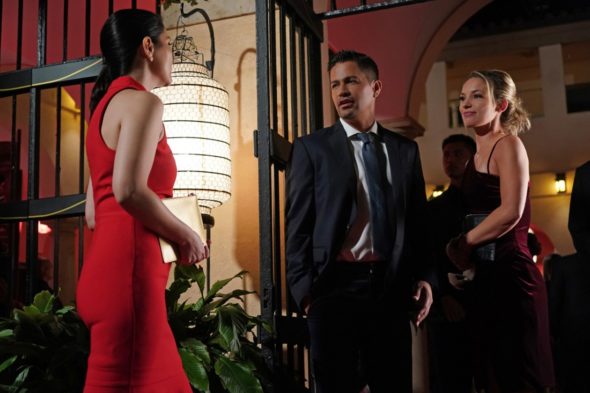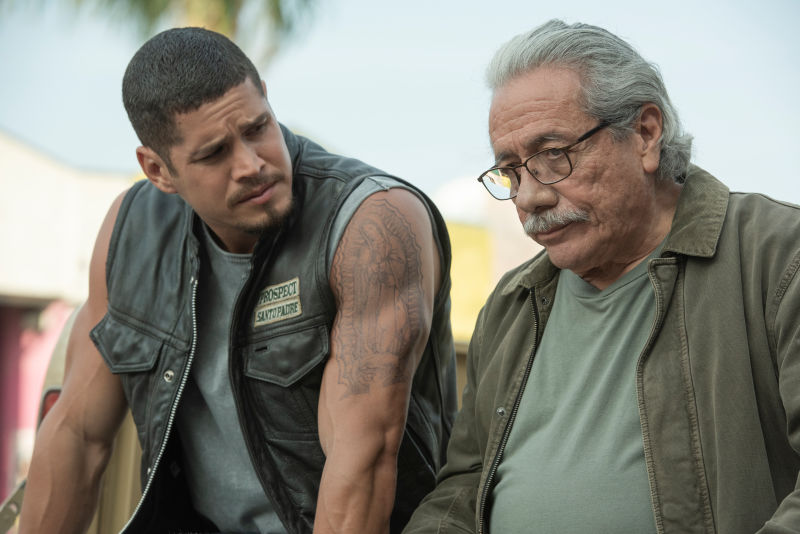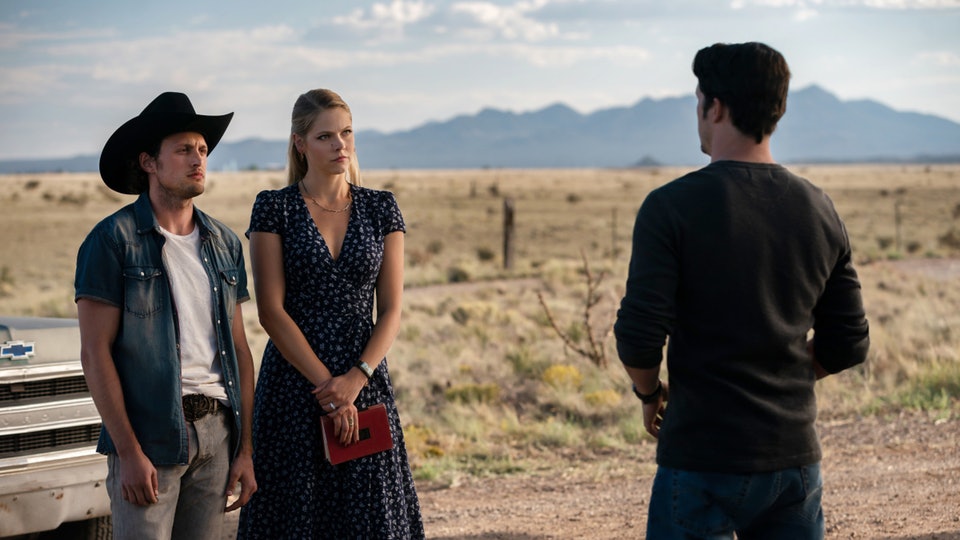Last August, fans of the original Magnum, P.I. series, which ran from 1980 through 1988 and starred the mustachioed Tom Selleck, got a chance to revisit their favorite Hawaiian detective, but with a difference. Executive producers, Peter Lenkov and Eric Guggenheim, sought to bring some much needed diversity to a storyline that originally involved mainly men, most of them white. Once more, the story of the war-veteran-turned-private-investigator is set in Hawaii, but the players have been updated for the new millennium. Higgins is played by a woman, Perdita Weeks, and Magnum is played by the man producers thought would best channel Selleck’s charm without being a copy, Latino actor Jay Hernández.
It’s certainly refreshing to hear that a Latino was cast simply because he was the best man for the job and it’s lovely to see a woman in a lead role in the reboot, considering female actors in the original were often given little to do and say on camera and even less to wear. But actors can only play the parts as they are written for them, and while producers made sure to include three female writers in their team of seven, which undoubtedly lends parity and verisimilitude to Higgins’ character development, unfortunately, the same can’t be said for our Latino Magnum. Without a single storyline or significant cultural detail to contextualize his latinidad, we are left with the sense that his culture in bound up with nothing more than the way he looks.

There are no Latinx writers in the Magnum, P.I. story room, which explains why the detective’s ethnicity is given no depth other than a joke or two per episode, the butt of which are the white characters. Hernández is asked to drop a Spanish phrase here and there, but there is no visible way in which his culture or race has shaped the show, beginning with the decision to preserve the Anglo-sounding titular character’s name. When a Latina writer questioned producers about the lack of representation in the writing room, the producers cited the difficulty in “finding writers”, a peculiar excuse to give to.… a Latina writer.
No one is complaining about more roles for Latino actors or about updating shows with better representation, but if the idea was to keep the spirit of the original show alive and make it better, perhaps it would have made more sense to make these titular characters Hawaiian. Instead, our lone Latino living in a television version of Hawaii (that is once again surprisingly low on Pacific islanders), feels somewhat like a token gesture. Despite this problem, which did not escape the attention of critics and public alike, the series was renewed for a second season, which will premiere in September 2019.
Our Ongoing Obsession with Reboots
Perhaps this is because the very notion of the reboot is an obsession right now, as network television continues to struggle to compete with Netflix and HBO. Producers rely on premises that worked in the past, even the distant one, under the assumption that it’s easier (better? more profitable?) to update a story than to come up with a new, contemporary one.
Reboots also offer the opportunity to correct the exclusionary practices of the past. While that is a laudable effort, updating a series in both setting and diversity requires a thoughtful touch if it’s to be successful. Magnum’s producers are likely banking on the nostalgic effect the show will bring up in those of us old enough to remember the original, but what about those who never saw it? Will the culturally strained premise work for them in the long run?
I don’t mean to single out the creators of the new Magnum — it’s not easy to consider all the aspects of culture within the framework of 22 minutes on air. A successful cultural reboot is a group effort between the show’s creators, the network, critics, and the audience, and even then there are no guarantees. Take the case of the One Day at a Time: producers gave their best efforts to make the cultural switch from a white single mom raising her brood to a Latina mom (Justina Machado), who struggles through a similar situation. The actors cast in the family roles were all Latinx, including the tour de force that is Rita Moreno in the role of the of the Cuban-American matriarch. The show entertained topics that are vibrant issues for the Latinx community, such as discrimination/bullying, financial instability, single-parenthood, and, one the current administration took hold, immigration.

Despite the care with which the program was populated with the appropriate people and settings, the excellent response from critics, and the devotion of fans who watched the three seasons, it was the network this time — Netflix — who missed the mark. Unlike the kind of marketing the network’s other shows enjoy, the kind that makes them instant cult classics, when their promo flashes as soon as we log into our account, One Day at a Time never received this stellar treatment. As disappointed fans remarked when they witnessed better promotion of the show’s cancellation than of its existence, Netflix’s excuse that they cannot justify renewal due to low ratings was lame. No amount of great writing and reimagining can save a reboot when the network refrains from highlighting what makes it different from the original and what makes it current.
It was probably the great success, albeit a short-lived one, of the One Day at a Time project that inspired other rebooters to consider how the climate in the United States affects different sectors of the population. Notably, the current administration’s misguided and disproportionate attention to Latinx immigration (so desperately on our minds as I write this on the day of one of the ICE’s threatened undocumented immigrant raids), has shifted the focus for the creators of Mayans M.C., a latinizado version of FX’s hit show about white bikers, Sons of Anarchy.
This time, the show follows the Hispanic biker club who used to rival the original gang and the action is set along both sides of the southern California border, exploring the issues that arise there. With a majority of the cast who is Latino, Emilio Rivera reprises his role from Sons of Anarchy, and remarks on the novel feeling of working with so many other actors who “look like him”. Despite Rivera’s fear that including storylines that deal with the current border issues would somehow mar the quality of the show, Mayans M.C., which premiered in 2018, has been given the green light for a second season.

Photo: Prashant Gupta (FX Networks)
Knowingly or not, Mayans M.C. opened the door to the social and political commentary that is desperately needed at this time, even from sources of what in a perfect world could get away with just being mindless entertainment. Two new reboots slated for the fall of 2019 prepare to tackle the topic of borders head on: one of them sets deportation as the show’s origin storyline, while the other relies on the magic of metaphor to make its point.
Teenage fans of the original Roswell (1999-2002), which aired on the CW, knew that this story about aliens living in our midst was really about them. Back in the beginning of the millennium, when we all still worried about Y2K and other techie and slightly supernatural disasters, talking about aliens connoted either UFO sightings or that feeling of being “other” or strange, much like many of us feel during adolescence and its aftermath. Indeed, that is what the 1999 series was getting at — it followed the lives of young people living in a place with ties to other planets, relating to one another without ever knowing who comes in peace and who does not. In other words, it was basically a show about kids in high school. Alienness, like vampirism and zombieness in other franchises, serves as a metaphor for the young-adult human condition.
Roswell, New Mexico returns to the same place, but years later, reprising some of the original roles. Liz, the lead character, is now played by a Latina actor and the town’s sheriff is not only Latina but a woman. Once again, aliens are living in their midst, but this time, the allusion is toward immigrants and the discrimination they face. In this reboot, the suspicion that someone is “alien” is no longer the bully’s way to torture an offbeat adolescent but an inquiry into the legal status of an immigrant who resides in one of these border states.

The fact that the series begins with a border crossing, as Liz return to New Mexico after living for two decades in Mexico, frames the story. The casting of Latinx actors also helps, although there are several characters who “act” as if they, too, are frightened of the authorities, even though they are played by Anglo actors and there is no visible evidence of their “otherness”. And while Liz, her father, and a few others are asked to utter a few lines in Spanish, these superficial trappings of culture aren’t taken very far within the plot. Like any good metaphor, I suppose, some of the fear and abuse Latinx immigrants are suffering at the border is left up to our imagination.
In the realm of the realistic, another reboot faces deportation fear straight on. When the original Party of Five premiered in the fall of 1994, the five Salinger kids, who ranged in age from a baby to a recent college grad, had just become orphaned. Their parents, who from all appearances had achieved a good level of success and comfort in the pre-Google era Bay area, had been killed in a collision with a drunk driver. The thrust of its six seasons was the survival of this family, headed up by the oldest sibling and consummate man-child, Charlie, who fears he will be found an unfit guardian. The siblings spend the first episodes trying to escape being split up and placed in foster care.
The first dramatic arc of the series is resolved at the end of the first season, which essentially saw Charlie rise to the challenge of finishing the job his parents had begun, despite his track record for being less than reliable. In the same way that the vast majority of Disney movies kill off the parental figures within the first ten minutes, precisely to catalyze a story that is infinitely more interesting when there is no adult to swoop in and solve it all, the original television drama was able to touch on many of the topics that affect teens and young adults: drugs, sex, domestic abuse, illness, and orphanhood. These mature topics were all the more resonant in the hands of the five Salinger kids, who had to work to understand, process, and resolve their issues without their parents to guide them.

The combination of this youth-friendly structure, in which America’s white teens saw their own grunge-rock, West Coast-tinged realities magnified on the small screen, together with appealing actors being given their breakthrough roles, and the show’s sensational contemporary soundtrack contributed to the great success of the show and the sense that it spoke for its generation. As the millennium turned, so too did the trend, and Party of Five became fodder for nostalgia.
Rolling with that very feeling of nostalgia, the original creators of Party of Five are premiering a reboot of the show this fall, and though its premise is quite different, they are not sparing any efforts to connect it to the original. Amy Lippman and Chris Keyser are bringing back the five siblings who must stay together and get through it all at any cost, but this time they won’t be orphans. Airing on Freeform in the fall, produced by Sony Entertainment (just like the original), the Salingers are now the Buendías, a Mexican-American family whose parents are deported unexpectedly.
Some of the problems that propelled the original series will be present again, notably the preoccupation that the eldest brother will be deemed insufficiently responsible for his siblings, though in this case Emilio fears discrimination by the government agencies, not the weight of his new responsibility like Charlie did. The trailer, which recently became available, sees the Buendía family split up along two separate sides of a fence. Mr. Buendía reminds Emilio in Spanish that he is strong and must stay that way for the sake of the family.
The scene is reminiscent of the reality at the border right at this moment; the children’s fears and the parents’ pain, an echo of what Hispanics are struggling through in this moment in time. So while it remains mysterious what effect the mention of the original show might have on audiences for the new one, updating the storyline, the family’s ethnicity, and the problems they will touch on, is certainly the first step in making the new Party of Five the voice of a new generation as well.
Other reboots, like Charmed, which has been renewed for another season, content themselves with simply increasing visibility for Latinx actors, without necessarily changing the entire cultural framework of the show. Now, one of the magical sisters is played by a Latina. Preferable to the half-baked approach that seems to satisfy the producers of Magnum, P.I. and Roswell, it might be preferable to simply diversify and reflect the world we live in. As Latinas grow out of being a minority, it’s heartening to see more of us on the screen.
Evaluating the various reboots latinizados of the upcoming season, it seems as if the Party of Five producers have gone the furthest to create a believable and current Latinx family in crisis. Only time will tell whether audiences appreciate it. What seems clear to me, though, is that properly and thoroughly translating a television concept into a different time and culture is a difficult thing to do right. There are so many shades of too little or too far, that I have to ask myself why producers seem to think reboots save time or promise success. Far more interesting and creative is the project of inventing brand-new and original content for Latinx audiences. Starz’s upcoming show, Vida, is attempting exactly that. A “love story to brown queerness”, its ensemble cast of women of color is like nothing we’ve ever seen before. And in a season full of reboots, that’s only a good thing.
For Image credit or remove please email for immediate removal - info@belatina.com





































